One of the ways we can do this, is by using defer with the PowerShell App Deployment Toolkit (PSADT)
How do you defer with PSADT?
To be able to defer an installation with PSADT, you need to use the Show-InstallationWelcome function. But this does not defer installation by it self.
There are two parameters with can use with Show-InstallationWelcome in order to defer install, those are:
-AllowDefer
This will give the user a popup with the choice to defer the install, every time the script is executed.
-AllowDeferCloseApps
This will give the user a popup with the choice to defer the install, but ONLY if the processes with the parameters -CloseApps are running. If they are not, it will ignore the defer and continue
Decide for how long to defer
Now we know how to defer, we need to find our, for how long. There are three methods. By x number of times the script is executed, by x days from first run, or by setting a deadline using a date.
Those Parameters are as following
- -DeferTimes
- -DeferDays
- -DeferDeadline
-DeferTimes and -DeferDays are with set with a INT value, eg 3. where the -DeferDate is set by entering a date.
Show-InstallationWelcome examples
Lets say we want to allow the user to defer the installation for up to 3 times, then we would use this
Show-InstallationWelcome -AllowDefer -DeferTimes 3
And that would look like this

In this example we want to defer 3 time again, but this time we do only want to do that, if Internet Explorer is running on the device.
Show-InstallationWelcome -AllowDeferCloseApps -DeferTimes 3 -CloseApps “iexplore”
And that would look like this
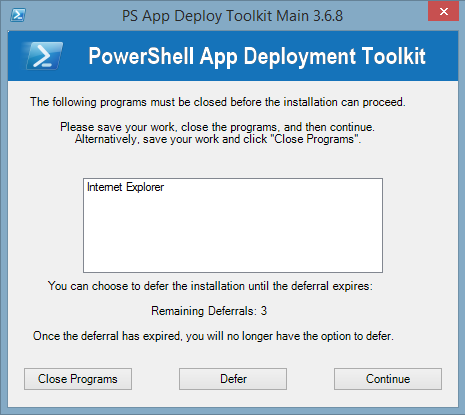
In the last example we want to allow the user to defer the installation for up to 5 days.
Show-InstallationWelcome -AllowDefer -DeferDays 5
And that would look like this
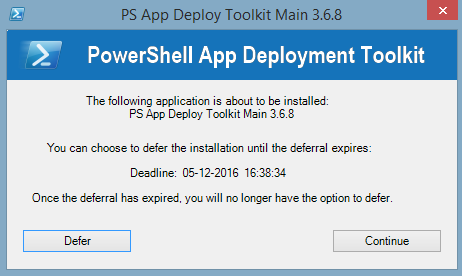
I hope this article helped you to understand the Show-InstallationWelcome and how to defer installations using the PowerShell App Deployment Toolkit.
Feel free to leave a comment below, and share how you use defer.
As a last thing i would like to share the full help information on Show-InstallationWelcome
NAME
Show-InstallationWelcome
SYNOPSIS
Show a welcome dialog prompting the user with information about the installation and actions to be performed before
the installation can begin.
SYNTAX
Show-InstallationWelcome [[-CloseApps] <String>] [-Silent] [[-CloseAppsCountdown] <Int32>] [[-ForceCloseAppsCountdo
wn] <Int32>] [-PromptToSave] [-PersistPrompt] [-BlockExecution] [-AllowDefer] [-AllowDeferCloseApps] [[-DeferTimes]
<Int32>] [[-DeferDays] <Int32>] [[-DeferDeadline] <String>] [-CheckDiskSpace] [[-RequiredDiskSpace] <Int32>] [[-Mi
nimizeWindows] <Boolean>] [[-TopMost] <Boolean>] [[-ForceCountdown] <Int32>] [-CustomText] [<CommonParameters>]
DESCRIPTION
The following prompts can be included in the welcome dialog:
a) Close the specified running applications, or optionally close the applications without showing a prompt (using
the -Silent switch).
b) Defer the installation a certain number of times, for a certain number of days or until a deadline is reached.
c) Countdown until applications are automatically closed.
d) Prevent users from launching the specified applications while the installation is in progress.
Notes:
The process descriptions are retrieved from WMI, with a fall back on the process name if no description is availab
le. Alternatively, you can specify the description yourself with a '=' symbol - see examples.
The dialog box will timeout after the timeout specified in the XML configuration file (default 1 hour and 55 minut
es) to prevent SCCM installations from timing out and returning a failure code to SCCM. When the dialog times out,
the script will exit and return a 1618 code (SCCM fast retry code).
PARAMETERS
-CloseApps <String>
Name of the process to stop (do not include the .exe). Specify multiple processes separated by a comma. Specify
custom descriptions like this: "winword=Microsoft Office Word,excel=Microsoft Office Excel"
-Silent [<SwitchParameter>]
Stop processes without prompting the user.
-CloseAppsCountdown <Int32>
Option to provide a countdown in seconds until the specified applications are automatically closed. This only t
akes effect if deferral is not allowed or has expired.
-ForceCloseAppsCountdown <Int32>
Option to provide a countdown in seconds until the specified applications are automatically closed regardless o
f whether deferral is allowed.
-PromptToSave [<SwitchParameter>]
Specify whether to prompt to save working documents when the user chooses to close applications by selecting th
e "Close Programs" button. Option does not work in SYSTEM context unless toolkit launched with "psexec.exe -s -
i" to run it as an interactive process under the SYSTEM account.
-PersistPrompt [<SwitchParameter>]
Specify whether to make the prompt persist in the center of the screen every 10 seconds. The user will have no
option but to respond to the prompt. This only takes effect if deferral is not allowed or has expired.
-BlockExecution [<SwitchParameter>]
Option to prevent the user from launching the process/application during the installation.
-AllowDefer [<SwitchParameter>]
Enables an optional defer button to allow the user to defer the installation.
-AllowDeferCloseApps [<SwitchParameter>]
Enables an optional defer button to allow the user to defer the installation only if there are running applicat
ions that need to be closed.
-DeferTimes <Int32>
Specify the number of times the installation can be deferred.
-DeferDays <Int32>
Specify the number of days since first run that the installation can be deferred. This is converted to a deadli
ne.
-DeferDeadline <String>
Specify the deadline date until which the installation can be deferred.
Specify the date in the local culture if the script is intended for that same culture.
If the script is intended to run on EN-US machines, specify the date in the format: "08/25/2013" or "08-25-2013
" or "08-25-2013 18:00:00"
If the script is intended for multiple cultures, specify the date in the universal sortable date/time format: "
2013-08-22 11:51:52Z"
The deadline date will be displayed to the user in the format of their culture.
-CheckDiskSpace [<SwitchParameter>]
Specify whether to check if there is enough disk space for the installation to proceed.
If this parameter is specified without the RequiredDiskSpace parameter, the required disk space is calculated a
utomatically based on the size of the script source and associated files.
-RequiredDiskSpace <Int32>
Specify required disk space in MB, used in combination with CheckDiskSpace.
-MinimizeWindows <Boolean>
Specifies whether to minimize other windows when displaying prompt. Default: $true.
-TopMost <Boolean>
Specifies whether the windows is the topmost window. Default: $true.
-ForceCountdown <Int32>
Specify a countdown to display before automatically proceeding with the installation when a deferral is enabled
.
-CustomText [<SwitchParameter>]
Specify whether to display a custom message specified in the XML file. Custom message must be populated for eac
h language section in the XML.
<CommonParameters>
This cmdlet supports the common parameters: Verbose, Debug,
ErrorAction, ErrorVariable, WarningAction, WarningVariable,
OutBuffer, PipelineVariable, and OutVariable. For more information, see
about_CommonParameters (http://go.microsoft.com/fwlink/?LinkID=113216).
-------------------------- EXAMPLE 1 --------------------------
PS C:\>Show-InstallationWelcome -CloseApps 'iexplore,winword,excel'
Prompt the user to close Internet Explorer, Word and Excel.
-------------------------- EXAMPLE 2 --------------------------
PS C:\>Show-InstallationWelcome -CloseApps 'winword,excel' -Silent
Close Word and Excel without prompting the user.
-------------------------- EXAMPLE 3 --------------------------
PS C:\>Show-InstallationWelcome -CloseApps 'winword,excel' -BlockExecution
Close Word and Excel and prevent the user from launching the applications while the installation is in progress.
-------------------------- EXAMPLE 4 --------------------------
PS C:\>Show-InstallationWelcome -CloseApps 'winword=Microsoft Office Word,excel=Microsoft Office Excel' -CloseAppsC
ountdown 600
Prompt the user to close Word and Excel, with customized descriptions for the applications and automatically close
the applications after 10 minutes.
-------------------------- EXAMPLE 5 --------------------------
PS C:\>Show-InstallationWelcome -CloseApps 'winword,msaccess,excel' -PersistPrompt
Prompt the user to close Word, MSAccess and Excel.
By using the PersistPrompt switch, the dialog will return to the center of the screen every 10 seconds so the user
cannot ignore it by dragging it aside.
-------------------------- EXAMPLE 6 --------------------------
PS C:\>Show-InstallationWelcome -AllowDefer -DeferDeadline '25/08/2013'
Allow the user to defer the installation until the deadline is reached.
-------------------------- EXAMPLE 7 --------------------------
PS C:\>Show-InstallationWelcome -CloseApps 'winword,excel' -BlockExecution -AllowDefer -DeferTimes 10 -DeferDeadlin
e '25/08/2013' -CloseAppsCountdown 600
Close Word and Excel and prevent the user from launching the applications while the installation is in progress.
Allow the user to defer the installation a maximum of 10 times or until the deadline is reached, whichever happens
first.
When deferral expires, prompt the user to close the applications and automatically close them after 10 minutes.

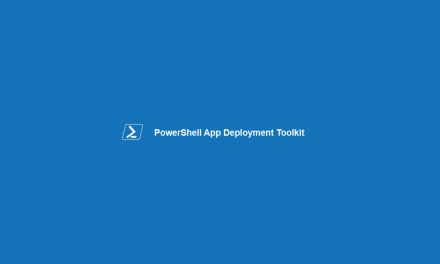

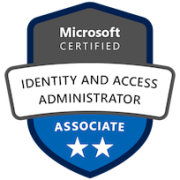
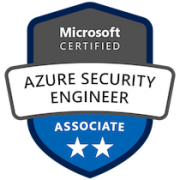
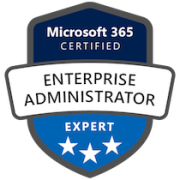
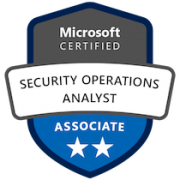
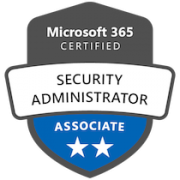
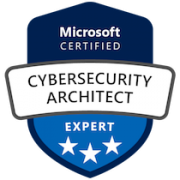
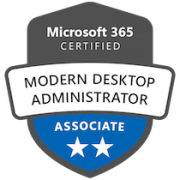
What methods are being used for subsequent showing of the message? The installation is pushed the first time which triggers the first deferral. Is the intent to push it again to trigger the next prompt? Other than maybe using the windows task scheduler, not sure how to trigger the message to show again.
Hi, pretty new to using this, so please forgive the question. I understand setting the deferral. Is there an option for reminders? Example: deferral is set to expire in 14 days. First prompt, user defers. More than likely they will forget about this by the next day. is there an option to set reminders and with options like, 1 day, 4hrs etc.? That way the users can be reminded based on their reminder intervals until the deferral threshold is reached.
Does the referral survive a reboot? I prefer to use the Acronym PAT for brevity, yes I know I am leaving the D out. I have been monitoring the development of PAT over the last few years and with it’s most recent release, I began a few months ago to convert all my package wrappers to it. I even have mult-nested PATs and they work great, a new form of task sequencing. A great tool for the Software Deployment Packager/SCCM Admin.
Hi,
Yes it does survive through a reboot, the defer history is set in the registry in the following key
The “PS_AppDeployToolkitMain_3.6.8_EN_01” part will change, to what you entered in the $appVendor, $appName and $appVersion variables.
Thanks for the comment!